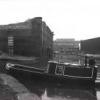-
Posts
328 -
Joined
-
Last visited
Profile Information
-
Gender
Male
-
Location
Napton
-
Occupation
Boatbuilder
-
Boat Name
Barrow
-
Boat Location
Midlands
Recent Profile Visitors
4,523 profile views
davidg's Achievements
-
davidg started following C&RT License Survey , Engine history , Alternative use of a C & H hand spike and 2 others
-
During my area training I went to the main exchange in Bradford. The standby generators there were big units, 6+ cylinders (didn't pay much attention to these), which started on compressed air. If they failed to start there was a donkey engine to recharge the air in the receiver which was a Lister JP2, that did attract my interest as I wondered how many more of these well maintained, low hours engines there were dotted around the phone network.
-
Getting strong clues from the buildings visible in this one😁
-
The tool in use is a brake stick, a specialised tool for use as a lever to apply brakes. A shunter's pole is a longer round pole with a pig's tail hook on the end for lifting three link couplings over coupling hooks and deftly twisting the pole to disengage the pig's tail.
-
or even kJ/kg☺️
-
Coombe Hill Canal?
-
061869 without the 100km reference
-
It is the GCR bridge at Loogabarooga then. The factory must have changed between the 1929(?) Aerofilms photo I found and the date of your photo.
-

Wonka film with some inland waterway boating.
davidg replied to Stroudwater1's topic in General Boating
Yes. -

Wonka film with some inland waterway boating.
davidg replied to Stroudwater1's topic in General Boating
If you are talking about the picture in Tim's post follow the rivets of the gunwhale angle as they approach the fore end. Yarwoods boats aren't like that. -
As the person who derailed this thread by objecting to this and subsequent similar claims I will attempt to put this to bed so contributors can get back to discussing the Schleswig-Holstein question. Some of this will be repeating what others have said and some of it is down to semantics, I hope that most (all? ...please) will be motherhood & apple pie*: First a definition: water used is the amount of water which must be added to a pound to maintain the water level. This is all the reservoir keepers (when such a thing existed) care about: how hard and for how long do I have to turn the valve on for? Secondly, said reservoir keepers don't care if the pound is full of water or 99% full of boat shaped holes in the water, so long as the remaining 1% of water keeps that gauge out of the red they can stay in bed. Part the third: when a lock is operated the amount of water which flows through the paddle holes is w x l x h and is independent of what is in the lock. Please don't argue with this, it just is. If you do wish to argue I'll leave it to others, I can't be bothered to waste my time drawing pictures etc. Next a digression from locks: imagine a pound with a boat in it. Draw a line across the pound in front of the boat, one side of the line where the boat is side a, other side of the line where the boat isn't is side b. Boat moves from a to b. a now contains more water, b contains less water. Does the lock keeper have to get out of bed to top b up? No, he doesn't because the boat shaped hole in the water occupies the same volume as the water which isn't there. a contains more water but does it run over the weir? No it doesn't, because the extra water fills the boat shaped hole which previously existed. Amazing how that works out isn't it? Does the boat “use” water by moving from a to b? Not by the definition in part 1, the reservoir keeper hasn’t had to do anything to maintain the water levels. Part 4: If a boat is worked through a lock then a boat shaped hole in the water will be transferred from one side of the lock to another. First the boat enters the lock and the gates are closed, the boat shaped hole in the water is now in the lock but the water levels in the lock chamber and the pound are exactly as they were before the boat entered. No reservoir keepers will be troubled by this. After filling (or emptying) the lock, tipping wxlxh litres of water through the lock (which will trouble the reservoir keeper) the gates can be opened and the boat can move out of the chamber. Now the boat shaped hole in the water is in the other pound but again, neither the level of water in the lock chamber nor the level in the pound have been altered by the act of the boat being moved out of the lock and the reservoir keeper can go back to bed. There is now less water in the pound the boat has entered (and more water in the pound it has left) but that water has been replaced by the boat shaped hole in the water (or the boat shaped hole in the water has been filled by water). What all of this means is that everyone is right. Yay! For the crack-the-egg-at-the-blunt-enders there is less water in the pound the boat now occupies and more in the pound the boat formerly occupied (so by this definition of water “used” larger/heavier boats should pay more for a licence when going up, and less when going down). For the crack-the-egg-at-the sharp-enders the reservoir keeper doesn’t care whether there are boats or water in the pound, all they care about is how much extra water is needed to maintain the water level which is wxlxh regardless of the size or number of boats worked through a lock. So, is everyone happy? *Things we can all agree on, Carver Mead 1981
-
Apologies for taking it off track but people were putting forward the argument (probaby tongue in cheek but you never know...) that widebeam boats use less water transiting a lock and should pay less for a licence. Personally I think it's a great argument, I could load my boat with 30 tons of coal* and get a huge licence reduction if it were true. Unfortunately it isn't. *I think I may have just spotted another flaw in my cunning money-saving scheme,
-
Well done Grasshopper, you have chosen the path of wisdom. Now spread the word and put an end to this old canard.
-
Much better than that. The water used in filling a lock (and the water tipped into the lower pound when emptying) depends only on the height difference between the pounds and the lock length x width. The displacement of the boats in the lock makes no difference, you are not filling a completely empty lock with a boat, or 2 boats, or no boats in it.
-
Is the correct answer. Funnily enough I said the bottom was 5/16" several dozen posts ago but then I've only owned the boat forty odd years so what do I know.
-
Who writes this stuff: "built by Harland & Wolff in 1937 with 10/6/4 plating" even allowing for metric equivalents if H&W put a 10mm bottom on they must have made it thicker than the first ones, mine was only 5/16". Would that 4 figure refer to the 4mm wooden cabin? Which moves us on to "the back cabin is largely unchanged from its days of cargo carrying": well if you count the old wooden cabin having been removed and a new steel cabin put in its place I suppose it is largely unchanged, apart from being made of a different material, a different shape, doors through to the engine room.....😂








